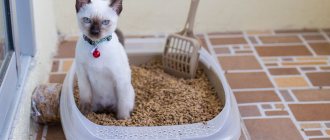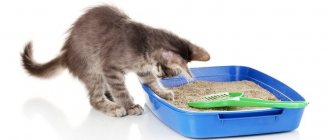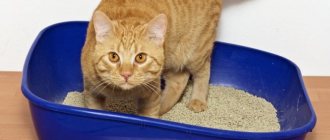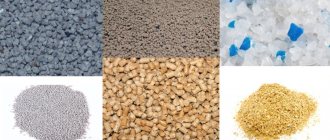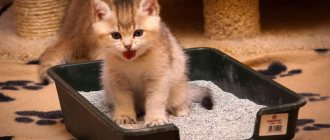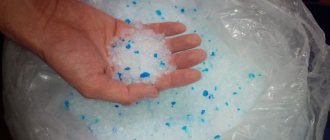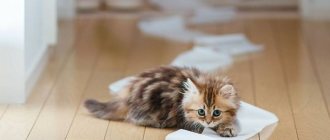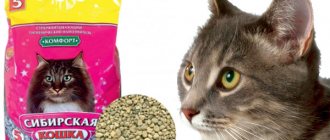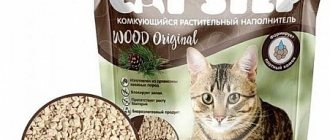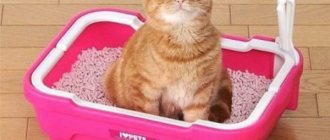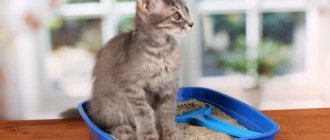Properly selected high-quality cat litter is a necessary attribute for accustoming an animal to a litter tray. This product performs several important functions. Firstly, it masks the unpleasant smell of bowel movements. Secondly, it keeps your pet's paws clean, helping him not to get dirty in the process of burying excrement. Thirdly, it provides the purr with maximum comfort, thanks to which the cat quickly gets used to going only to the litter box when needed and nowhere else.
Products from different manufacturers cope with the described tasks differently. What products for cats can be found on the modern market and how do they differ from each other?
Classification of cat litter with photos
The properties of the tray filler depend primarily on the composition of the product. Modern manufacturers, be it the well-known Catsan or Zoonik, popular in narrow circles, produce several types of cat litter products:
- woody;
- silica gel;
- mineral (zeolite);
- clay;
- corn.
According to the principle of action, fillers are:
- clumping - when wet, their granules stick together into hard balls, which must be removed from the tray along with excrement;
- absorbent - do not lose their structure when absorbing moisture.
Clumping: advantages and disadvantages
The main component of any clumping product is clay bentonite. This is a specific material that has the unique ability to swell when exposed to moisture, clogging liquid particles inside its porous structure. To increase absorption properties and mask unpleasant odors, manufacturers often mix bentonite with other materials of similar properties, such as sawdust. At the same time, any clumping cat litter has a number of undeniable advantages:
How it works
There are two types of filler, differing in their principle of action. The components either absorb secretions and odors, or form dense structures in the form of lumps with urine, which are easily separated from the main mass.
Absorbent filler
Convenient for cats as it quickly absorbs large amounts of liquid. Manufacturers use natural raw materials that are safe for animal health: special types of clay, corn, sawdust, and pulp.
Most manufacturers do not add flavorings, but the composition may include soda, activated carbon or silver ions - these components significantly improve the characteristics of the absorbent filler.
It is inexpensive, but requires more frequent replacement compared to clumping ones, and regular disinfection of the tray itself. There is an advantage to this - with frequent washing, the risk of pathogenic microorganisms multiplying in the contents of the cat litter is much lower.
Important! Opt for an absorbent one if your pet has access to the outdoors (you walk it on a harness or take it to the dacha). Absorbent litter is the best option when there are several cats living in the house.
clumping
This type of brand is more popular, since the clumping filler is convenient for owners. For its production, bentonite is often used, a clay mineral with excellent absorption properties. Wood, paper and some other materials are also used as raw materials.
Why do cat owners love clumping litter? In addition to the obvious advantages - cost-effectiveness and ease of cleaning, some brands have special additives that change color depending on the composition of the urine. So, if the animal is sick, and there are no external symptoms yet, the unusual color of these additives will allow the owner to seek help from a veterinarian in time.
See also: Rating of the TOP 7 best hearing aids for the elderly
A number of manufacturers include substances that change color when exposed to urine. The purpose of such additives is to clearly define the boundaries of the lump. Therefore, the pet owner can save money by not throwing away clean litter. Many brands contain a variety of fragrances - components that are useless for cats, but pleasant for owners.
Absorbent: advantages and disadvantages
Absorbent fillers are those that do not change their structure when interacting with liquids. The product simply absorbs moisture and odors until it is completely saturated with them.
The cat litter product has its advantages:
- economical - absorbent fillers are inexpensive and last a long time;
- naturalness – products of this type are made from environmentally friendly materials that are not subject to chemical treatment;
- absence of extraneous dirt and odors - no matter how many cats live in the house, they will all be able to use one tray;
- ease of disposal - most fillers can be flushed down the toilet after use without fear of causing a blockage.
In terms of their performance properties, absorbent fillers are many times superior to clumping ones. However, before choosing this seemingly best option, you need to consider a few more points:
- Unpleasant odors are retained well by such fillers, but not for long. As a result, the tray begins to emit specific “aromas” even when its contents are barely even half dirty.
- Some cats may refuse to relieve themselves where they should until the litter in their litter box is completely replaced. With this approach, absorbent products are consumed faster than clumping ones.
- Animals prefer fillers that resemble soil in structure. Absorbent ones are not one of these, and therefore some cats refuse to use them.
Of course, the properties of a product depend not only on its type, but also on its composition. Which type of cat litter has the highest customer ratings and why?
Comparison table of characteristics
The table below presents the main characteristics of the products in question. By comparing them with each other, it will be much easier for you to choose a quality filler.
| Product Name | Compound | Features of the filler | Animal age |
| Fresh Step Extreme Clay | mineral components, clay | protection against unpleasant odors, antibacterial effect | any |
| Cat's Best Original | woody | protection against unpleasant odors, biodegradable, washable and safe filler | adult |
| Catsan Hygiene Plus | sand | antibacterial effect, protection against foreign odors, removal of germs | any |
| N1 Crystals | silica gel | New generation antibacterial silica gel filler perfectly absorbs moisture | different |
| Pi-Pi-Bent Classic | clumping clay | environmentally friendly safe filler, clumps well | different |
| Pussy-Cat Oceanic | zeolite | absorbent filler, blocks unpleasant odors, has a pronounced antibacterial effect | any |
| Ever Clean Multiple Cat 10 l | clumping clay filler | has a pronounced antibacterial effect, protects against foreign odors and does not contain fragrances | adult |
Silica gel fillers
Silica gel cat litter is a godsend for those who value cleanliness and the absence of foreign odors in the house above all else. Made from silicon mixed with water, this product is an excellent sorbent. When wet, porous granules of silicone filler form lumps that reliably retain not only liquids but also odors inside, allowing the tray to remain fresh for 2-3 days without cleaning.
Silica gel is a very economical material. A large (50 kg) bag lasts one cat for about a year. When used, silica gel does not generate dust, so you don’t have to worry that an animal will spread particles of the product throughout the house on its paws. True, it is difficult to recycle such material. When wet, silica gel forms strong crystals, which are strictly prohibited from being flushed down the toilet.
Customer Reviews
If you are still undecided on the type of filler, try reading reviews from other furry owners. As a rule, they already have experience in toilet training a cat, which was gained through trial and error. Here's what pet owners say about litter trays:
Sources
- https://MrKot.com/kakoi-napolnitel-vybrat
- https://kotoholik.com/tovary-dlia-koshek/napolniteli-dlya-tualetov.html
- https://gafki.ru/koshki/napolnitel-dla-kosacego-tualeta.html
- https://vash.market/dom-i-dacha/dlya-zhivotnyh/koshachij-napolnitel.html
- https://vyborexperta.ru/zhivotnye/luchshie-napolniteli-dlya-koshachego-tualeta/
- https://catmolly.com/napolniteli-dlya-koshek/
Did the article help you?
Andrey
Ask questions
Ask questions and write answers in the comments
Mineral fillers
Mineral fillers are called clumping fillers made on the basis of zeolite. Due to their low cost (from 100 rubles per kg), such products are the most frequently purchased in their segment.
At the same time, the performance properties of such fillers leave much to be desired. Zeolite generates dust, releasing harmful substances that are dangerous to animals (especially young ones). It absorbs moisture well, but does not completely remove the unpleasant odor of excrement. Finally, zeolite, like any clumping material, cannot be flushed down the toilet, which complicates the process of its disposal.
Difference between fillers according to the principle of action
According to the principle of action, there are two types of fillers: absorbent and clumping.
Absorbent type
Capable of absorbing and retaining moisture. Its structure is not subject to change. The granules should be replaced only after they have been thoroughly soaked in liquid. If you allow liquid to appear at the bottom of the tray, an unpleasant aroma will quickly make itself known.
Considering the frequent digging of granules by cats, they very quickly mix with used ones, so it is recommended to remove them more often than clumping ones. The absorbent type of kibble is best for 2-3 cats. When replaced, the granules release an unpleasant odor that was previously retained.
Clumping filler
Lumps form where moisture gets in and are easily removed from the tray. Lumps should be removed every day, and solid granules should be refilled.
By filling the filler with a layer of 8-9 cm, you can achieve its efficiency and excellent retention of unpleasant odors.
Granules are usually purchased with a reserve, since one package must be filled completely, and the other allows you to renew the used tray. The clumping type will be a real boon for nurseries where cats live in large numbers .
How to choose the best filler?
To purchase a high quality product, you should make sure that it has:
- Excellent absorbent properties that will help absorb moisture efficiently.
- Does not contain harmful substances that can cause irreparable harm to the health of the owner and his pet.
- Simplicity and ease of use.
Clay fillers
Clay fillers are made from bentonite and other materials with similar properties. Depending on the impurities included in their composition, such products are either clumping or absorbent. There are types of clay litter with small and large granules designed for cats of different ages and preferences.
The only drawback common to all such products is dust. It will rise whenever the animal decides to visit the toilet or you are going to change the used litter and pour a new one into the tray.
Tips for choosing
When choosing a filler, pay attention to several main aspects:
- Age of the animal. There are universal fillers suitable for cats of different ages. There are fillers only for adults and only for kittens.
- Compound. As a rule, absorbency, reliability and frequency of replacement will depend on it. There is a table with the types of composition, their advantages and disadvantages in our article a little higher.
- Volume. Pay attention to the frequency of replacement. The higher it is, the larger the product package should be. Otherwise, the filler will run out at the most inopportune moment.
Rating of the best cat litters: which one to choose?
When discussing which mixture to choose - silicone or bentonite, corn or wood - we must not forget that the rating of pet products is formed based on a variety of criteria. For pet owners, the price of the product, its environmental friendliness, versatility and even ease of packaging are equally important. We have compiled our own rating of pet products, identifying the best mixtures according to certain criteria:
- "Lenta" is the most accessible. The low price of the product (from 150 rubles per 5 kg package) and the opportunity to purchase it in any hypermarket of the same name have made this mixture one of the most frequently purchased in the Russian Federation. The product is made from fine bentonite chips, due to which it does not have the best performance properties and has corresponding consumer reviews.
- "Catsan Ultra" is the most hygienic. This premium product is highly regarded for its ability to keep your home clean. Possessing excellent moisture-absorbing and odor-masking properties, Katsan, however, is made only from natural materials. These will not harm your pet if swallowed. Thanks to this, Katsan can be used for toilet training very young kittens.
- "Katty" is the highest quality. Produced at the Bryansk clay processing plant, this mixture earns only positive consumer reviews year after year. The product is made from natural raw materials, which are mined there in the region. Thanks to this brand, it is possible to maintain the high quality of its products at relatively low prices.
Cat behavior when using the toilet
In some cases, the cat completely refuses to use the toilet and does its business in the most unexpected places, while avoiding the tray itself or using it in an unusual way, for example, sleeping in it.
By this, the animal shows that this toilet does not recognize, and most often the reason is dissatisfaction with the filler.
It is impossible to talk to a cat directly and find out its opinion on this issue, but the animal’s behavior can tell a lot to an attentive and caring owner.
Most cats that do not suffer from mental problems do not show dissatisfaction and go to the toilet with any litter. The exception is when the material contains any compounds that cause allergies in the animal. Then it cannot use its toilet purely physically.
In general, a cat’s requirements for litter can be outlined by the following points:
- the material should not contain any flavorings so that nothing distracts the animal’s keen sense of smell;
- the particles should not rustle loudly, knock or make any loud sounds, since cats prefer not to reveal their location to a hypothetical enemy during such an intimate process;
- It should be comfortable for the cat to dig into the tray; it is best if the filler particles are easily mixed and do not stick to the paws or raise dust;
- it is desirable that the material was natural, at least partially.
All cat owners are familiar with their pet's behavior in the toilet. These animals, with varying degrees of energy, dig out a place for themselves to relieve themselves, and then bury them. This behavior is due to the fact that all domestic cats descend from wild ancestors who were forced to take care of their own safety.
Most mammals on our planet navigate the world around them mainly by smell. Good eyesight or acute hearing are also inherent in some of them, but everyone smells smells, drawing from them the information necessary to choose a behavioral strategy. Excrement can tell a lot about an animal to another member of the fauna.
If any animal enters the territory of a wild cat, it can draw conclusions about the gender, age, hormonal background, physical health and mental state of the cat by the smell of feces. But like an animal that cares about its safety and anonymity, the cat prefers not to leave any information about itself, so it carefully buries its excrement.
Domestic cats seem to have no need to perform this ritual and ensure safety, but almost all of them continue to bury their excrement. The cat teaches this to the kitten along with all other skills. It is a fixed behavioral pattern that animals continue to pass on from generation to generation, despite the fact that it has lost its practical value.
In addition, the genes of a cautious predator make cats constantly worry about survival and safety. Even a calm home environment and an always filled bowl does not make them careless; they are always ready to survive in any conditions. And they continue to follow the traditions learned from their mother.
Sometimes cats don't bury their excrement, and that should tell a sensitive owner a lot. There may be several reasons for a change in behavioral pattern. The cat may not hide evidence of his presence for the same reasons that in other conditions he carefully “destroys evidence.” It's about establishing your dominant role.
This behavior is especially common in uncastrated cats who are trying to establish their power in the house in ways available to them.
In most cases, this is due to the fact that there are several animals living in the house, especially if there are two or more mature cats. People call this behavior “marking territory”; it is for this purpose that cats leave their urine, saliva, feces, and rub against corners with glands that secrete odorous substances. This is how they establish their rights.
In some cases, cats stop burying feces for emotional reasons. If there are “clouds gathering” in the house, a difficult emotional situation, cats feel this very keenly. Then their behavior can change greatly, and they stop performing some usual actions, and, on the contrary, begin to behave in an unexpected way.
Quite rarely, but still sometimes cats are simply embarrassed to do their business in front of someone. Of course, the concept of shyness cannot be fully applied to cats. This behavior is due to the fact that when an animal is observed, it does not feel safe.
In such cases, we are not talking about a filler that we don’t like. It may be worth considering purchasing a closed litter box where your pet will be protected from prying eyes.
